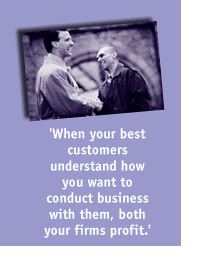
The Open Kimono Approach
| Ïðîäàæè | ||||
| Sales.com | ||||
| Keeping... | ||||
by Diane Sanchez, Stephen E. Heiman, and Tad Tuleja
One of the cherished principles of business operation is that you play your cards close to your chest with your customers as well as your competition, sharing with them only what you can’t avoid revealing. That may have been fine for the days of selling as mortal combat, where customers were considered marks to be tagged and deluded. As we enter this revolutionary era of the sales process, however, it’s a principle whose fundamental flaws are being revealed everywhere.
 Today,
the most progressive sales organizations, the most successful consulting
groups, are taking exactly the opposite approach, opening their minds
and strategies to the companies they do business with, because they understand
that this is essential in Win-Win relationships. This doesn’t mean necessarily
that you have to open your books to your customers, or that you share
with them every minor glitch in your own organization. It means that,
in those areas where you and they share a vested interest, you make “partnership”
a reality by letting them know what you think – and especially what you
think about doing business together.
Today,
the most progressive sales organizations, the most successful consulting
groups, are taking exactly the opposite approach, opening their minds
and strategies to the companies they do business with, because they understand
that this is essential in Win-Win relationships. This doesn’t mean necessarily
that you have to open your books to your customers, or that you share
with them every minor glitch in your own organization. It means that,
in those areas where you and they share a vested interest, you make “partnership”
a reality by letting them know what you think – and especially what you
think about doing business together.
Mike McCarver, vice president of corporate sales for KLA Instruments, calls this the “open kimono” approach. The idea behind it is mutual self-interest: the conviction that when your best customers understand how you want to conduct business with them, both your firms profit – and that a certain amount of “card showing” is therefore essential.
In accordance with this principle, our recommendation is that, when you’re dealing with a customer whose business is important enough to you to justify doing an extended analysis, you consider sharing that analysis with its subject. If the customer is truly a partner, you won’t lose by doing so. If, on the other hand, you see this as tipping your hand or giving away trade secrets, then you probably don’t have the kind of relationship with this customer that we’re recommending.
One member of our field staff, Brian Polowniak, says that sharing information is simply part of a sensible, open strategy to tell his buyers, at the beginning of each sales call, what commitment he hopes to get from them by then end of the meeting – as well as what he’s ready to commit in return. “Laying your expectations out up front,” he points out, “saves the person what he probably needs most, which is time.” Brian also shares his “ideal customer” profile with prospects. “I spell it out. `Here is what we’re looking for in our clients. Here are our best fits.’ If he connects with that, you’ve both saved time. If he doesn’t, it probably doesn’t matter.”
Mike Johnson, Vice President of Alliances at Becton Dickinson Infusion Therapy, agrees. “When we’re dealing with our top-tier customers,” Mike says, “the movement is toward `You open your books and I’ll open mine.’ The trust factor is central. And the real courage comes when you sit a customer down with an account analysis and show him where the shared interests are, and where there are problems.
“We come right out and say it. `Here, Jim, you can see that we have you down as a red flag. I just don’t feel that your palm trees and my palm trees are the same. What can we do to understand you better. It’s a revelation, believe me, when they see that. They might be shocked or confused, but it confirms the trust factor, and so it keeps you moving in the right direction.”
What your share with your customers – how much or how little – depends on you. We won’t presume to give you specific guidelines on how to enter this admittedly touch area. But one thing has been proved again and again in our dealings with our own best customers. The most productive and stable relationships we’ve ever developed have rested not on willful ignorance, but on mutual education. If you’re working with people, not against them, you begin on the same page.
“Same page” or “open kimono” relationships are what some call joint-venture partnerships, or what Mike Johnson’s company calls customer alliances. Such alliances are increasing in popularity every year, and because they are so important to revenue, protecting them against erosion is a business necessity.
Adapted from Selling Machine
Diane Sanchez, Stephen E. Heiman and Tad Tuleja © 1997 by Miller Heiman, Inc. All rights reserved with permission of Times Books, a division of Random House